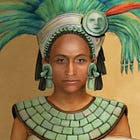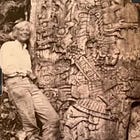Maya Queen's Discovery Unearths Game of Thrones Style Palace Intrigue
Part 3: Maya Warrior Queens
Hola Amigos! If you read enough history, you soon discover it never fails to amaze. We get so caught up in our modern world, we rarely think about the fact that our problems today are not unique. The world, and our ancestors, have seen it all before. George R.R. Martin knew it. Even though his Game of Thrones is fictional, the emotions are real—lust, love, greed, power grabs—we’ve been there before, either on the page or off. I never thought archeology could detect nuances and emotions from across the centuries, but it does. Since breaking the Maya code in the 1970s, we can now read that ancient culture like a book. This is a continuation of my series on Maya warrior queens.
PART 3
Did palace intrigue exist a thousand years ago in the kingdoms of Maya kings and queens? Apparently so. As in the adage, "Revenge is a dish best served cold," some vindications were even cross-generational.
A Calakmul king in Yucatán's southern lowlands retrieved an important stela (limestone slab placed before pyramids) that had been discarded for nearly a hundred years. It was to be included in a burial chamber for his beloved queen and wife, Lady K'abel, and would re-establish the family connection of his wife and another famous woman ruler—but from generations earlier—Lady Ikoom, also from Calakmul, the famous Snake kingdom. 1
This change of address for a nearly forgotten stela was an act of love by a Maya king whose queen had just died. Though it was a century after war had upended his kingdom—revenge still burned. And as things sometimes go, in politics and war, the defeat had lasted only for a while.
The discovery of Stela 44 at the Guatemalan El Perú-Waka' archeological site in 2013 unleashed a discussion about the ruling Maya kingdoms of Tikal, Calakmul, and El Perú-Waka' from the seventh century. 2Prior to the discovery of this large limestone slab, very little was known about the titans of these ruling factions.
Introducing Lady Ikoom
Lady Ikoom, also known as White Spirit, was predecessor to one of the greatest queens of Maya civilization, seventh century Holy Snake Lord Lady K'abel, who was also the Kaloomté, or military commander, of El Perú-Waka'. (See Supreme War Lord post, Lady Kabel).
Archeologists wager around 700 CE, Stela 44 was brought to the main city temple by command of Lady K'abel's husband, King K'inich Bahlam II, to be buried as an offering in the funeral rituals for his recently departed queen.
Political pawns
Princesses first, both Lady Ikoom and Lady K'abel were used as political pawns in marriages to powerful rulers of the Snake Dynasty of Calakmul. Though Lady K'abel's name has been bandied about for 15 years, until discovery of Stela 44, Lady Ikoom was unknown, as was her husband, Waka' King Chak Took Ich’aak.
According to Dr. David Freidel, professor of anthropology in Arts and Sciences at Washington University, St. Louis, co-director at the El Perú-Waka' site in Guatemala with Lic. Juan Carlos Pérez, the discovery of this stela offers a wealth of new information about a "dark period" in Maya history sometimes known as The Hiatus. Stela 44 introduced the names of two previously unknown Maya rulers and the political issues that shaped their legacies.
New chapter for El Perú-Waka’
Freidel's epigrapher, Stanley Guenter, who deciphered the hieroglyphic text, believes Stela 44 was originally dedicated roughly 1450 years ago, around 564 CE, by the Waka' dynasty king, Wa'oom Uch'ab Tzi-kin, or He Who Stands Up the Offering of the Eagle.
Scholars believe the stela was left out in the elements, an act of disrespect, when political ideologies shifted and Ikoom and her husband's clan fell out of favor. But it's likely, said Freidel, that the king prized this stela because as scion of the Snake Dynasty, Lady Ikoom would have had a familial connection both to him and his recently deceased wife. Fragments of another stela, Stela 43, found in the temple walls in 2013, also mention Lady Ikoom. In this stela, Ikoom is given pride of place on the front of that monument celebrating an event in 574 CE
War and political intrigue
The stela tells a riveting story of war and political intrigue. The front shows a king cradling a sacred bundle in his arms. Two other stela at this site share this same pose and were probably raised by King Chak Took Ich'aak, whose name was used earlier by two Tikal kings. It's likely that this king of Waka' was named after them and that his dynasty was as a Tikal vassal at the time he came to the throne, said Freidel.
White Spirit
The text describes the accession of Chak Took Ich'aak's son which was witnessed by Lady Ikoom, who was most likely his mother. Her title, White Spirit, suggests she was a holy person and was linked to the powerful Snake Kingdom monarchy of El Perú-Waka', a vassal state of Calakmul, making it likely that Lady Ikoom was a Snake princess, according to Freidel's epigrapher, Guenter.
The inscription reveals the death of Chak Took Ich'aak's father, which ushered in a period of political turmoil as various groups grasped for supremacy. Chak Took Ich'aak's son ultimately took the throne.
Much later, by the king retrieving Stela 44 and bringing it to his wife's burial site, this action put things back in order to re-establish the leadership and imperial dynasty of his clan.
Changing alliances
Scholars, including Freidel, assume, "At some time in his reign, King Chak Took Ich'aak changed sides and became a Snake dynasty vassal."
But when he died and his son became heir to the throne, he did so under a foreign king, which Freidel's epigrapher, Guenter, argued— after deciphering the hieroglyphics—was the king of Tikal, not Waka. In other words, King Chak Took Ich'aak's son came under the power of Tikal. Somehow Queen Ikoom survived this existential change of political favor. That in itself is a minor miracle.
The Maya political landscape underwent a huge turnabout beginning 556 CE with the Snake Dynasty on the rise and Tikal in decline. "A dramatic tide shift occurred," continues Freidel, "when that same Tikal king, Wak Chan K'awii, was defeated and sacrificed by the Snake King in 562 CE."
Two years after that major reversal, the new king and his mother raised Stela 44 at the pyramid site to its rightful place, telling the story outlined here. Game of thrones indeed. Only difference, this one happened in the land of the Maya, not Westeros of George R.R. Martin's Game of Thrones' fame.
Alan Boyle. “Ancient monument adds spicy twist to Maya Game of thrones saga.” NBC News. July 17, 2013.
Editorial Staff. “New Monument Found at El Peru-Waka Guatemala, Tells Story of Mayan Cleopatra.” Sci-News. Summer 2013.















The Mayan and other indigenous cultures are fascinating.
Love your posts Jeannine!